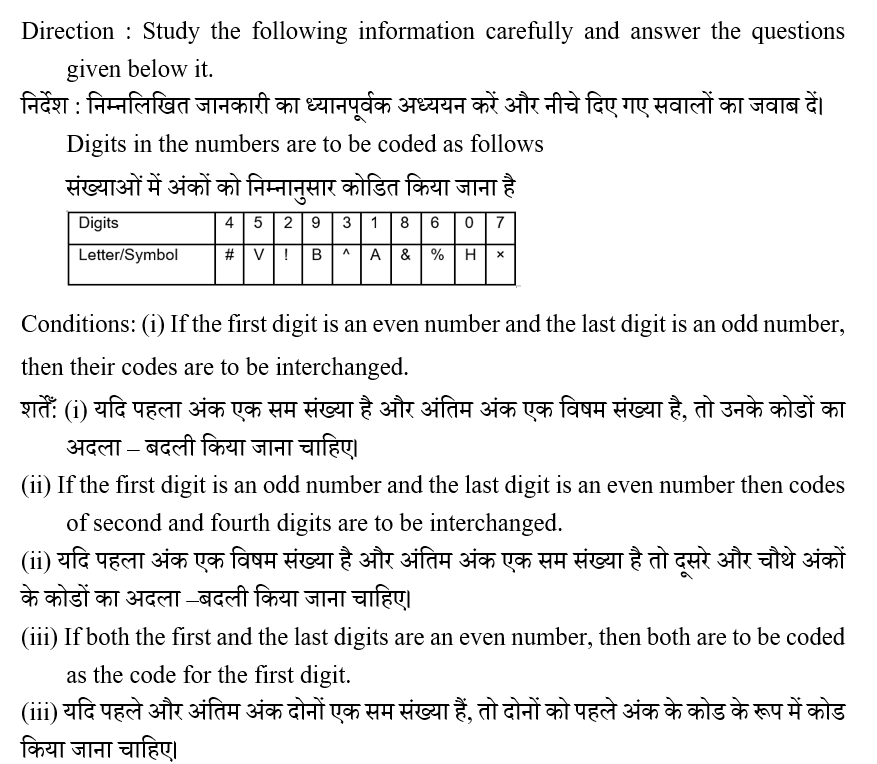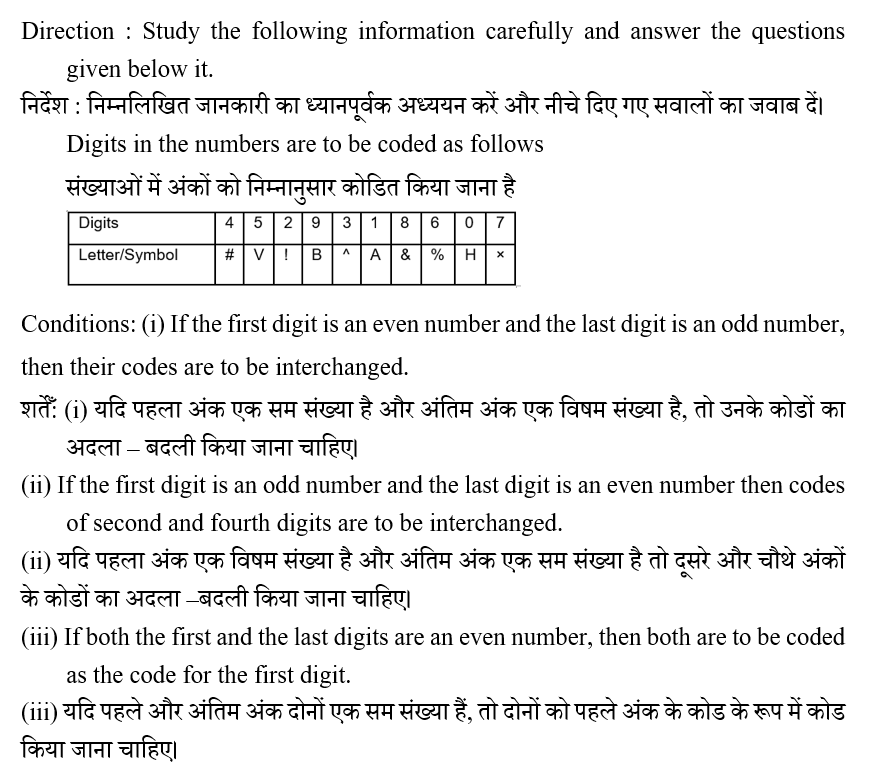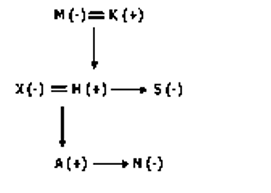Question 1: 

Question 2: 

Question 3:
Direction : Study the following information carefully and answer the questions given below.
निर्देश : निम्नलिखित जानकारी का ध्यानपूर्वक अध्ययन करें और नीचे दिए गए प्रश्नों का उत्तर दें।
There are eight persons sitting in a straight line and all of them are facing south. They are i.e. P, Q, R, S, T, U, V, and W are sitting with equal distance but not necessarily same order. Each one likes different cars i.e. Mercedes Benz, Audi, BMW, Volvo, Range Rover, Porsche, Bentley, and Jaguar but not necessarily in the same order.
U sits third to the right of V, who likes Jaguar. The one who likes Audi and the one who likes Volvo sit immediate neighbors and both of them sit right of the U. P sits third to the left of the one who likes BMW. Only one person sits between S and the one who likes Mercedes Benz. T, who likes Bentley is an immediate neighbor of V. Neither V nor U sits in the extreme ends. W sits one of the extreme ends. P doesn’t like Range Rover. The one who likes BMW sits an Immediate left of U. There are two persons sit between R and the one who likes Audi. U doesn’t like Mercedes Benz.
सीधी रेखा में आठ लोग बैठे हैं और वे सभी दक्षिण की ओर मुख किए हैं। वे सभी अर्थात् P, Q, R, S, T, U, V, और W एक-समान दूरी में बैठे हैं लेकिन जरूरी नहीं कि उसी क्रम में। प्रत्येक को अलग-अलग कारें पसंद हैं यानी मर्सिडीज बेंज, ऑडी, बीएमडब्ल्यू, वोल्वो, रेंज रोवर, पोर्श, बेंटले और जगुआर लेकिन जरूरी नहीं उसी क्रम में।
U, V के दाईं ओर तीसरे स्थान पर बैठता है, जो जगुआर पसंद करता है। वह जो ऑडी पसंद करता है और जो वोल्वो पसंद करता है वे निकटतम पड़ोसी है और दोनों U के दाईं ओर बैठते हैं। P, बीएमडब्ल्यू पसंद करने वाले व्यक्ति के बाईं ओर तीसरे स्थान पर बैठता है। S और मर्सिडीज बेंज पसंद करने वाले व्यक्ति के बीच केवल एक व्यक्ति बैठता है। T, जो बेंटले पसंद करता हैं, V का निकटतम पड़ोसी है। न तो V न ही U अंतिम छोर पर बैठते हैं। W अंतिम छोरों में से किसी एक में बैठता है। P, रेंज रोवर पसंद नहीं करता है। जो बीएमडब्ल्यू पसंद करता है वह U के तुरंत बाईं ओर बैठता है। R और जो ऑडी पसंद करता हैं, के बीच दो लोग बैठते हैं। U, मर्सिडीज बेंज पसंद नहीं करता है।
Who are the immediate neighbors of the one who likes Audi?
ऑडी पसंद करने वाले व्यक्ति के निकटतम पड़ोसी कौन हैं?
Question 4:
Direction : Study the following information carefully and answer the questions given below.
निर्देश : निम्नलिखित जानकारी का ध्यानपूर्वक अध्ययन करें और नीचे दिए गए प्रश्नों का उत्तर दें।
There are eight persons sitting in a straight line and all of them are facing south. They are i.e. P, Q, R, S, T, U, V, and W are sitting with equal distance but not necessarily same order. Each one likes different cars i.e. Mercedes Benz, Audi, BMW, Volvo, Range Rover, Porsche, Bentley, and Jaguar but not necessarily in the same order.
U sits third to the right of V, who likes Jaguar. The one who likes Audi and the one who likes Volvo sit immediate neighbors and both of them sit right of the U. P sits third to the left of the one who likes BMW. Only one person sits between S and the one who likes Mercedes Benz. T, who likes Bentley is an immediate neighbor of V. Neither V nor U sits in the extreme ends. W sits one of the extreme ends. P doesn’t like Range Rover. The one who likes BMW sits an Immediate left of U. There are two persons sit between R and the one who likes Audi. U doesn’t like Mercedes Benz.
सीधी रेखा में आठ लोग बैठे हैं और वे सभी दक्षिण की ओर मुख किए हैं। वे सभी अर्थात् P, Q, R, S, T, U, V, और W एक-समान दूरी में बैठे हैं लेकिन जरूरी नहीं कि उसी क्रम में। प्रत्येक को अलग-अलग कारें पसंद हैं यानी मर्सिडीज बेंज, ऑडी, बीएमडब्ल्यू, वोल्वो, रेंज रोवर, पोर्श, बेंटले और जगुआर लेकिन जरूरी नहीं उसी क्रम में।
U, V के दाईं ओर तीसरे स्थान पर बैठता है, जो जगुआर पसंद करता है। वह जो ऑडी पसंद करता है और जो वोल्वो पसंद करता है वे निकटतम पड़ोसी है और दोनों U के दाईं ओर बैठते हैं। P, बीएमडब्ल्यू पसंद करने वाले व्यक्ति के बाईं ओर तीसरे स्थान पर बैठता है। S और मर्सिडीज बेंज पसंद करने वाले व्यक्ति के बीच केवल एक व्यक्ति बैठता है। T, जो बेंटले पसंद करता हैं, V का निकटतम पड़ोसी है। न तो V न ही U अंतिम छोर पर बैठते हैं। W अंतिम छोरों में से किसी एक में बैठता है। P, रेंज रोवर पसंद नहीं करता है। जो बीएमडब्ल्यू पसंद करता है वह U के तुरंत बाईं ओर बैठता है। R और जो ऑडी पसंद करता हैं, के बीच दो लोग बैठते हैं। U, मर्सिडीज बेंज पसंद नहीं करता है।
Who sits an immediate left of the one who sits third to the Right of BMW?
बीएमडब्ल्यू के दाईं ओर तीसरे स्थान पर बैठने वाले व्यक्ति के तुरंत बाईं ओर कौन बैठता है?
Question 5:
Direction : Study the following information carefully and answer the questions given below.
निर्देश : निम्नलिखित जानकारी का ध्यानपूर्वक अध्ययन करें और नीचे दिए गए प्रश्नों का उत्तर दें।
There are eight persons sitting in a straight line and all of them are facing south. They are i.e. P, Q, R, S, T, U, V, and W are sitting with equal distance but not necessarily same order. Each one likes different cars i.e. Mercedes Benz, Audi, BMW, Volvo, Range Rover, Porsche, Bentley, and Jaguar but not necessarily in the same order.
U sits third to the right of V, who likes Jaguar. The one who likes Audi and the one who likes Volvo sit immediate neighbors and both of them sit right of the U. P sits third to the left of the one who likes BMW. Only one person sits between S and the one who likes Mercedes Benz. T, who likes Bentley is an immediate neighbor of V. Neither V nor U sits in the extreme ends. W sits one of the extreme ends. P doesn’t like Range Rover. The one who likes BMW sits an Immediate left of U. There are two persons sit between R and the one who likes Audi. U doesn’t like Mercedes Benz.
सीधी रेखा में आठ लोग बैठे हैं और वे सभी दक्षिण की ओर मुख किए हैं। वे सभी अर्थात् P, Q, R, S, T, U, V, और W एक-समान दूरी में बैठे हैं लेकिन जरूरी नहीं कि उसी क्रम में। प्रत्येक को अलग-अलग कारें पसंद हैं यानी मर्सिडीज बेंज, ऑडी, बीएमडब्ल्यू, वोल्वो, रेंज रोवर, पोर्श, बेंटले और जगुआर लेकिन जरूरी नहीं उसी क्रम में।
U, V के दाईं ओर तीसरे स्थान पर बैठता है, जो जगुआर पसंद करता है। वह जो ऑडी पसंद करता है और जो वोल्वो पसंद करता है वे निकटतम पड़ोसी है और दोनों U के दाईं ओर बैठते हैं। P, बीएमडब्ल्यू पसंद करने वाले व्यक्ति के बाईं ओर तीसरे स्थान पर बैठता है। S और मर्सिडीज बेंज पसंद करने वाले व्यक्ति के बीच केवल एक व्यक्ति बैठता है। T, जो बेंटले पसंद करता हैं, V का निकटतम पड़ोसी है। न तो V न ही U अंतिम छोर पर बैठते हैं। W अंतिम छोरों में से किसी एक में बैठता है। P, रेंज रोवर पसंद नहीं करता है। जो बीएमडब्ल्यू पसंद करता है वह U के तुरंत बाईं ओर बैठता है। R और जो ऑडी पसंद करता हैं, के बीच दो लोग बैठते हैं। U, मर्सिडीज बेंज पसंद नहीं करता है।
How many persons sit between the one who likes Range Rover and V?
रेंज रोवर पसंद करने वाले व्यक्ति और V के बीच कितने व्यक्ति बैठते हैं?
Question 6:
Direction : Study the following information carefully and answer the questions given below.
निर्देश : निम्नलिखित जानकारी का ध्यानपूर्वक अध्ययन करें और नीचे दिए गए प्रश्नों का उत्तर दें।
There are eight persons sitting in a straight line and all of them are facing south. They are i.e. P, Q, R, S, T, U, V, and W are sitting with equal distance but not necessarily same order. Each one likes different cars i.e. Mercedes Benz, Audi, BMW, Volvo, Range Rover, Porsche, Bentley, and Jaguar but not necessarily in the same order.
U sits third to the right of V, who likes Jaguar. The one who likes Audi and the one who likes Volvo sit immediate neighbors and both of them sit right of the U. P sits third to the left of the one who likes BMW. Only one person sits between S and the one who likes Mercedes Benz. T, who likes Bentley is an immediate neighbor of V. Neither V nor U sits in the extreme ends. W sits one of the extreme ends. P doesn’t like Range Rover. The one who likes BMW sits an Immediate left of U. There are two persons sit between R and the one who likes Audi. U doesn’t like Mercedes Benz.
सीधी रेखा में आठ लोग बैठे हैं और वे सभी दक्षिण की ओर मुख किए हैं। वे सभी अर्थात् P, Q, R, S, T, U, V, और W एक-समान दूरी में बैठे हैं लेकिन जरूरी नहीं कि उसी क्रम में। प्रत्येक को अलग-अलग कारें पसंद हैं यानी मर्सिडीज बेंज, ऑडी, बीएमडब्ल्यू, वोल्वो, रेंज रोवर, पोर्श, बेंटले और जगुआर लेकिन जरूरी नहीं उसी क्रम में।
U, V के दाईं ओर तीसरे स्थान पर बैठता है, जो जगुआर पसंद करता है। वह जो ऑडी पसंद करता है और जो वोल्वो पसंद करता है वे निकटतम पड़ोसी है और दोनों U के दाईं ओर बैठते हैं। P, बीएमडब्ल्यू पसंद करने वाले व्यक्ति के बाईं ओर तीसरे स्थान पर बैठता है। S और मर्सिडीज बेंज पसंद करने वाले व्यक्ति के बीच केवल एक व्यक्ति बैठता है। T, जो बेंटले पसंद करता हैं, V का निकटतम पड़ोसी है। न तो V न ही U अंतिम छोर पर बैठते हैं। W अंतिम छोरों में से किसी एक में बैठता है। P, रेंज रोवर पसंद नहीं करता है। जो बीएमडब्ल्यू पसंद करता है वह U के तुरंत बाईं ओर बैठता है। R और जो ऑडी पसंद करता हैं, के बीच दो लोग बैठते हैं। U, मर्सिडीज बेंज पसंद नहीं करता है।
Which of the following person likes Porsche car?
निम्नलिखित में से कौन सा व्यक्ति पोर्श कार पसंद करता है?
Question 7:
Direction : Study the following information carefully and answer the questions given below.
निर्देश : निम्नलिखित जानकारी का ध्यानपूर्वक अध्ययन करें और नीचे दिए गए प्रश्नों का उत्तर दें।
There are eight persons sitting in a straight line and all of them are facing south. They are i.e. P, Q, R, S, T, U, V, and W are sitting with equal distance but not necessarily same order. Each one likes different cars i.e. Mercedes Benz, Audi, BMW, Volvo, Range Rover, Porsche, Bentley, and Jaguar but not necessarily in the same order.
U sits third to the right of V, who likes Jaguar. The one who likes Audi and the one who likes Volvo sit immediate neighbors and both of them sit right of the U. P sits third to the left of the one who likes BMW. Only one person sits between S and the one who likes Mercedes Benz. T, who likes Bentley is an immediate neighbor of V. Neither V nor U sits in the extreme ends. W sits one of the extreme ends. P doesn’t like Range Rover. The one who likes BMW sits an Immediate left of U. There are two persons sit between R and the one who likes Audi. U doesn’t like Mercedes Benz.
सीधी रेखा में आठ लोग बैठे हैं और वे सभी दक्षिण की ओर मुख किए हैं। वे सभी अर्थात् P, Q, R, S, T, U, V, और W एक-समान दूरी में बैठे हैं लेकिन जरूरी नहीं कि उसी क्रम में। प्रत्येक को अलग-अलग कारें पसंद हैं यानी मर्सिडीज बेंज, ऑडी, बीएमडब्ल्यू, वोल्वो, रेंज रोवर, पोर्श, बेंटले और जगुआर लेकिन जरूरी नहीं उसी क्रम में।
U, V के दाईं ओर तीसरे स्थान पर बैठता है, जो जगुआर पसंद करता है। वह जो ऑडी पसंद करता है और जो वोल्वो पसंद करता है वे निकटतम पड़ोसी है और दोनों U के दाईं ओर बैठते हैं। P, बीएमडब्ल्यू पसंद करने वाले व्यक्ति के बाईं ओर तीसरे स्थान पर बैठता है। S और मर्सिडीज बेंज पसंद करने वाले व्यक्ति के बीच केवल एक व्यक्ति बैठता है। T, जो बेंटले पसंद करता हैं, V का निकटतम पड़ोसी है। न तो V न ही U अंतिम छोर पर बैठते हैं। W अंतिम छोरों में से किसी एक में बैठता है। P, रेंज रोवर पसंद नहीं करता है। जो बीएमडब्ल्यू पसंद करता है वह U के तुरंत बाईं ओर बैठता है। R और जो ऑडी पसंद करता हैं, के बीच दो लोग बैठते हैं। U, मर्सिडीज बेंज पसंद नहीं करता है।
Who sits an immediate left of P?
P के तुरंत बाईं ओर कौन बैठता है?
Question 8:
How many digits in the number “76498381” gets repeated if the digits which are less than 5 is added by 1 and the digits which are more than 5 is subtracted by 1?
"76498381" संख्या में कितने अंक पुनरावृत होते हैं यदि 5 से कम वाले अंकों में 1 जोड़ा जाता हैं और 5 से अधिक वाले अंकों से 1 घटाया जाता है?
Question 9:
Directions : Study the information given below and answer the questions carefully.
निर्देश : नीचे दी गई जानकारी का अध्ययन करें और प्रश्नों का सावधानी से उत्तर दें।
There are seven members in a family. All are interrelated to each other. H is the only brother of S. S is the only aunt of N. N is the only daughter of X. M is the mother– in– law of X, who is the sister– in– law of S. K is the paternal grandfather of A.
एक परिवार में सात सदस्य हैं। सभी एक-दूसरे से जुड़े हुए हैं। H, S का एकमात्र भाई है। S, N की एकमात्र चाची है। N, X की एकमात्र बेटी है। M, X की सास है, जो S की भाभी/ननद है। K, A का दादा हैं।
How is A related to M?
A, M से कैसे संबंधित है?
Question 10:
Directions : Study the information given below and answer the questions carefully.
निर्देश : नीचे दी गई जानकारी का अध्ययन करें और प्रश्नों का सावधानी से उत्तर दें।
There are seven members in a family. All are interrelated to each other. H is the only brother of S. S is the only aunt of N. N is the only daughter of X. M is the mother– in– law of X, who is the sister– in– law of S. K is the paternal grandfather of A.
एक परिवार में सात सदस्य हैं। सभी एक-दूसरे से जुड़े हुए हैं। H, S का एकमात्र भाई है। S, N की एकमात्र चाची है। N, X की एकमात्र बेटी है। M, X की सास है, जो S की भाभी/ननद है। K, A का दादा हैं।
If S has a daughter V, then how is V related to H?
यदि S की बेटी V है, तो V, H से कैसे संबंधित है?








